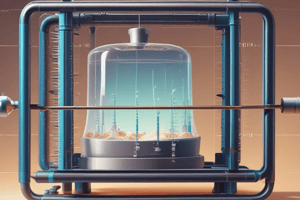Podcast
Questions and Answers
How does an increase in temperature affect the kinetic energy of gas particles?
How does an increase in temperature affect the kinetic energy of gas particles?
- Decreases the kinetic energy
- Increases the kinetic energy (correct)
- Halts the motion of gas particles
- Has no effect on the kinetic energy
What is the relationship between temperature and the number of collisions between gas particles?
What is the relationship between temperature and the number of collisions between gas particles?
- Directly proportional (correct)
- Inversely proportional
- Temperature stops collisions
- No relationship
How is pressure defined in the context of gases?
How is pressure defined in the context of gases?
- Temperature of gas particles
- Volume of gas particles
- Velocity of gas particles
- Force per unit area by a gas (correct)
What causes an increase in pressure in a gas according to the Kinetic Theory?
What causes an increase in pressure in a gas according to the Kinetic Theory?
What is the relationship between temperature and pressure in an ideal gas according to the Ideal Gas Law?
What is the relationship between temperature and pressure in an ideal gas according to the Ideal Gas Law?
Why do real gases deviate from the Ideal Gas Law at low temperatures or high pressures?
Why do real gases deviate from the Ideal Gas Law at low temperatures or high pressures?
How do real gases like water and carbon dioxide deviate from the Ideal Gas Law at low temperatures or high pressures?
How do real gases like water and carbon dioxide deviate from the Ideal Gas Law at low temperatures or high pressures?
What does the Ideal Gas Law predict about the behavior of gases under specific conditions?
What does the Ideal Gas Law predict about the behavior of gases under specific conditions?
Why is understanding the Kinetic Theory of Gases important for predicting gas properties?
Why is understanding the Kinetic Theory of Gases important for predicting gas properties?
In what scenarios can the Ideal Gas Law serve as a useful approximation despite real gases deviating from it?
In what scenarios can the Ideal Gas Law serve as a useful approximation despite real gases deviating from it?
Flashcards are hidden until you start studying
Study Notes
Exploring the Kinetic Theory of Gases: Temperature and Pressure Relationship
The Kinetic Theory of Gases, formulated in the 19th century, provides a fundamental understanding of how gases behave at the molecular level. This theory is crucial as it links macroscopic properties like temperature and pressure to the microscopic motion of gas particles. Let's delve into the relationship between temperature and pressure in gases, using the Kinetic Theory as a foundation.
The Kinetic Model
According to the Kinetic Theory, a gas is composed of a multitude of particles, such as atoms or molecules, which are in constant, random motion. These motions are responsible for the gas's properties, including its temperature and pressure.
Temperature
Temperature is a measure of the average kinetic energy of the gas particles. When the temperature of a gas increases, the kinetic energy of its particles also increases, causing them to move faster. As a result, the number of collisions between particles increases, leading to higher pressure.
Pressure
Pressure is the force applied per unit area by a gas. In the Kinetic Theory, pressure is the result of the collisions between gas particles and the walls of their container. The more rapidly the particles move, the more frequently collisions occur, resulting in increased pressure.
The Ideal Gas Law
The relationship between temperature and pressure in an ideal gas is described by the Ideal Gas Law, which is given by the equation:
PV = nRT
Here, P represents the pressure, V is the volume, n is the number of moles of the gas, R is the ideal gas constant, and T is the temperature in Kelvin.
From this equation, we can deduce that an increase in temperature, and consequently in kinetic energy, leads to an increase in pressure, assuming that the volume and the number of moles remain constant.
Real Gases and Deviations
Real gases deviate from the Ideal Gas Law due to intermolecular forces between their constituent particles. For example, the forces between molecules in real gases like water or carbon dioxide can cause the gas to deviate from the Ideal Gas Law at low temperatures or high pressures.
However, the Ideal Gas Law still remains a useful approximation for many real gases under common conditions.
Conclusion
The Kinetic Theory of Gases provides a framework for understanding the relationship between temperature and pressure in gases by considering the gas particles as tiny, fast-moving entities. The Ideal Gas Law offers a convenient equation for predicting the behavior of gases under specific conditions, although real gases often deviate from the ideal behavior due to intermolecular forces.
Understanding the fundamental principles of the Kinetic Theory of Gases can help us predict and interpret the properties of gases, from their temperature-pressure relationships to their behavior under various conditions.
Studying That Suits You
Use AI to generate personalized quizzes and flashcards to suit your learning preferences.




